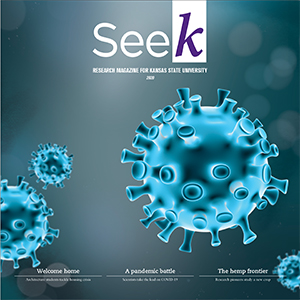Meet Joe Barbercheck
Joe Barbercheck joined K-State in November 2017 as associate director of research safety and industrial hygiene for the Department of Environmental Health and Safety, or EHS. He recently took time to answer a few questions about himself and how he and his department work with K-State researchers.
What is your background?
I hold undergraduate degrees in molecular biology and neuroscience and a master’s degree in microbiology and immunology from Tulane University. I also hold an MBA in operations from the Boston University Questrom School of Business. Prior to coming to K-State, I was associate director of research safety at Boston University. I began my career as a bench scientist developing animal models of disease associated with emerging and re-emerging viral pathogens. Because of that experience, I’m sensitive to how critical research processes are, the timing of experiments, and the pressure scientists can experience when conducting research. I bring that perspective to EHS, so as we’re developing policies and programs, I’m looking through the lens of what is practicable for researchers. We’re here to support the creation of knowledge and innovation.
What are the responsibilities of your position?
I am responsible for programs in EHS that are aimed at supporting the safe conduct of research across the research mission at K-State — research in the field, in the lab, and so on. I work with department health and safety committees and campus committees to make sure they have the tools they need to do self-assessments, inventories, and monitor their own progress.
By “safe conduct of research,” we mean identifying hazards and mitigating risk wherever we can. We take as broad a view of that as possible. That could be indoor air quality monitoring, respiratory protection, chemical or biological hazards—anything faculty, staff or students at K-State might encounter in a research setting.
How does EHS operate in the decentralized structure at K-State?
One strength is having a lot of different stakeholders and participants in the health and safety function. We get a lot of viewpoints, which helps us in identifying and assessing hazards. The department and college level is where people are really engaged in research. They are on the ground — really seeing what’s going on. Having the ability to interact with them and get their perspective is helpful to us.
Because of that decentralized structure, EHS acts as an institutional resource. Instead of EHS being the entity that’s inspecting labs and dictating policy, we’re more of a consultancy, or a repository of expertise to share with people to give them the tools they need to support health and safety within their function. That enables EHS to focus on collaboration and support.
What resources and tools do you provide, and how do researchers access them?
The important thing for researchers to know is that as they think about the safe conduct of research, they don’t have to reinvent the wheel. We have a lab safety manual, chemical hygiene plans, and other training and inventory templates and tools they can draw on that hopefully make their jobs easier and help the institution create consistency across functions. All of these are available on the EHS website. Most importantly, our contact information is on the website. If anyone has questions or they aren’t sure how something works or what’s available, we encourage them to reach out. We are here to help.
What else do researchers need to know?
We do have a lab registration process. An interactive tool on our website collects some basic inform about labs simply and quickly. Researchers list an emergency contact, necessary precautions, hazards, and click submit to send that information to us, then they can print that and post it outside the lab. One reason we do this is so we can share it with first responders: if there’s a spill or a fire, we want to be able to notify the correct contact person for that lab as quickly as possible. Posting it at the lab is also important so researchers are communicating to anyone in the area—visitors, custodians, or students. Many researchers have done a great job, but we’re always trying to achieve more participation.
We are also working to align some existing programs. Each department has a safety coordinator. Those coordinators conduct some safety inspections, and we have worked to provide those folks with templates and tools and give information to the campus EHS committee. We are trying to make that efficient and effective for the safety coordinators and the labs. We are also collaborating with the University Research Compliance Office to make sure that we’re sharing information and being transparent with existing lab inspections programs with IBC and IACUC. We want to minimize the burden on the researchers. We want good information sharing and a reliable inspection process across these different functions in a way that a researcher working with animals and biologicals and chemicals isn’t getting inspected six times!
I’m happy to talk to researchers anytime! I welcome their questions at barberch@ksu.edu or 785-532-3410.

